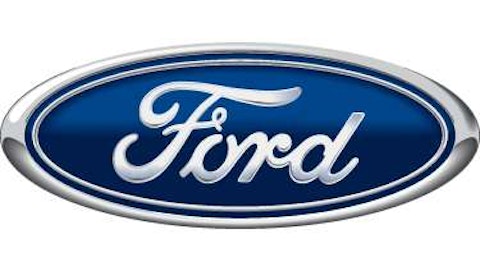“Fordism”: then & now
While GM became one of the first mega-corporations in America, Ford Motor Company (NYSE:F) entered the scene with one of the first breakthroughs in industrial manufacturing: the assembly line. This development by Henry Ford Motor Company (NYSE:F), the company founder, focused on mass production and affordability of the car. It was this process that gave the world the Model T and other iconic Ford lines. The method became so successful, the concept of mass production and affordability became known as “Fordism”, after the company. While not as big as GM, globally and financially, Ford created its own niche with cars like the Thunderbird and the Mustang, symbols of the rebellious Baby Boomer generation and the charged-up post-war economy in the US.
Like General Motors Company (NYSE:GM), it had to shed some of its brands to stay afloat, like Land Rover and Jaguar to Indian company Tata Motors, and was relying on its loan financing arm for profits for much of the late 2000’s as the recession took hold, as car sales decreased while fuel prices and retiree health care costs skyrocketed. Ford Motor Company (NYSE:F) went through its own 9-year stretch of declining car sales, but like GM, has rebounded in the last 10 years, with 2012 sales at near 2007 levels.
Assembly line cars still a global hit
Ford also looks to benefit from the Chinese market, posting record sales figures last month in the region, as well as a first-half record as well. In the first half of 2013, compared with 2012, China sales rose by 47%, but operating margins for the company came in lower than last year thanks to a still weak European marketplace, where the company lost $460 million in pre-tax earnings last quarter.
Domestically, cars like the Ford Motor Company (NYSE:F) Focus remain one of the green-tech standards worldwide, as well as the #1 sold car in the world. Last year, sales topped one million units, an over 100,000 unit increase from 2011, and it seems like there is no intention of slowing production anytime soon. This will help Ford out with its global footprint, owing to an ability to create a cheap car that is also economically friendly. Add a surge in Chinese sales, and Ford has a very profitable future.
The bottom line
In the past, I have hyped Ford quite a bit, mainly because I like its strong quarterly dividend of $0.40/share and solid 34% return on equity, but GM is nearly as good. For a cheaper forward P/E of 7.9, you get an E/P ratio of 8.4% growth, comparable to Ford’s 8.8% ratio. Profit margins for both companies are about 4% as well, so either company has the potential to be a good addition. However, General Motors Company (NYSE:GM) appears to be more about security at the moment while Ford Motor Company (NYSE:F) is about growth, given the movement in share price the last few years.
With a revival in the American car, which has been pretty much confirmed with the last two years of solid earnings, and the potential of huge Chinese growth over the next few years, the future of the car may not be foreigners selling cars to Americans, but rather, Americans selling cars to foreigners once again.
The article A Financial Salute to America: Part III – Car Talk originally appeared on Fool.com and is written by John McKenna.
John McKenna has no position in any stocks mentioned. The Motley Fool recommends Ford and General Motors. The Motley Fool owns shares of Ford. John is a member of The Motley Fool Blog Network — entries represent the personal opinion of the blogger and are not formally edited.
Copyright © 1995 – 2013 The Motley Fool, LLC. All rights reserved. The Motley Fool has a disclosure policy.



